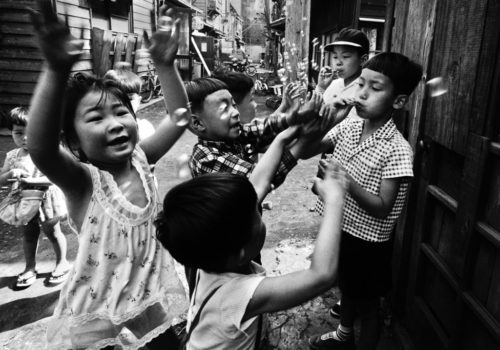In his living room in Paris, William Klein flips through the new edition of his book, Tokyo, which just arrived from Japan. Klein, always particular, is pleased with the quality of the thick, glossy paper which enhances the contrasts of his 1961 photographs. Tokyo is a major work by Klein, part historical document and part personal diary. Over the course of three months, he captured the madness and strangeness of the city at the dawn of the turbulent 1960s. He returned from the trip with over 1,000 photographs. William Klein revisited that journey.
Adélie de Ipanema : In 1961, you set out for Tokyo, which you knew very little about. How did that adventure begin ?
William Klein : My two first books, Life is Good and Good for You in New York: Trance Witness Revels and Rome, became cult classics in Japan. Some sponsors and cultural institutions invited me there to do a book on Tokyo. It was a very demanding work because, unlike New York and Rome, I was unfamiliar with this country. I cast myself into the unknown. For me, Tokyo was like another planet, and I wondered how the Japanese would accept by vision of their city.
A.D.I. : How did the Japanese welcome you ?
W.K. : In Tokyo, the newspapers were all talking about the project. I remember one headline that read, “William Klein Arrives To Shoot Portrait of Our City.” Sometimes, when I was taking pictures, people would duck out of the way because they knew it was for the book. They were intrigued, too. It’s true that an American photographer in Tokyo in the early ‘60s was a little bit crazy. Hiroshima was no picnic. But I was very well received. I was a guest of honor, noteworthy, whereas when I was in New York nobody gave a damn… It’s funny.
A.D.I. : For the first time ever, your book project was fully funded from the start. How did the collaboration work with your partners ?
W.K. : I had invitations from several groups, including companies who wanted me to use their products, e.g., Fuji. But I didn’t want any of them. At the time, it wasn’t good quality, and I preferred to buy Kodak. I said so, and it was very embarrassing because the Japanese don’t like to lose face. I was also embarrassed because a group of young, local photographers wanted to help develop my film and prepare the contact sheets. But I don’t like it when someone looks at my pictures before I do, especially since they were a little bit obsessed with everything I was doing.
A.D.I. : You’ve influenced so many photographers over there. You might take some pride in that… ?
W.K. : It’s a little annoying.
A.D.I. : Did you feel like you had total freedom during your stay.
W.K. : Of course. But sometimes cultural differences posed problems. I remember photographing the emperor and his wife from rather close up during a public event. That caused a scandal. One does not approach the emperor—it isn’t done. Then there are rules I learned along the way but which made me lose a lot of time. I asked one of the big daily newspapers at the time, Yomiuri Shimbun, which also owned a big baseball team, the Yomiuri Giants, to put me in touch with their star player for a portrait. Arranging that took forever: the head of the newspaper had to offer a gift to the coach and then the coach had to offer one to the person who made the request, etc. I got the meeting in the end, but I never imagined it could be so complicated. I thought all it would take was a phone call, but no, we had to play by their rules.
A.D.I. : You still broke a few rules. The Butoh dancers you photographed in the street, for example.
W.K. : They knew my work and wanted me to photograph them in their studio. But I told them, “It’s boring in the studio, let’s go into the street.” So we did it outside. The dancers were walking along the big boulevards, in the business districts, the subway. It was the first time they had a “happening” in the street. Afterwards, the photographs were widely circulated. I also met the boxer-painter Shinohara, who was part of a neo-Dadaist group. He performed a boxing demonstration on a roll of paper hanging on a wall. It’s funny because I saw him again by chance and photographed him in the summer of 2013 in Brooklyn. I asked his wife why she spoke such good English and not him. She told me, “Because artists are stupid. Women are more intelligent. And he’s an idiot when it comes to learning languages!”.
A.D.I. : Today the book Tokyo is highly sought after by collectors. Your work is part of the city’s heritage.
W.K. : It’s funny to say that what I did played a role in the country’s history. The book was out of print and a Japanese publisher came to ask me to make a new edition. Apparently it’s doing quite well over there. The collectors and photo world professionals are delighted. That’s nice. And what about the exhibition at Polka? Do you think it will work out?
« Tokyo » : Interview with William Klein
By Adélie de Ipanema, Polka.
EXHIBITION
Tokyo 61+ William Klein
From march 7th to May 9yh, 2015
Polka Galerie
12 rue St Gilles
75003 Paris
France
http://www.polkagalerie.com
* « Tokyo 1961, William Klein », éd. Akio Nagasawa Publishing, nouvelle édition limitée à 1 000 exemplaires signés et numérotés, 240 €. Disponible à la galerie Polka, 12, rue SaintGilles, Paris IIIe.
















